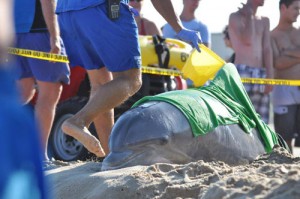
OCEAN CITY – An “unusual mortality event” that has not occurred in the past 25 years is the cause for hundreds of dolphins washing ashore in the region and unfortunately in this case nature has to take its course, officials report.
Since at least mid-July, National Oceanic and Atmospheric Administration (NOAA) Fisheries Stranding Network members, including the National Aquarium’s Marine Animal Rescue Program (MARP) and the Maryland Department of Natural Resources, have been responding to an alarming increase in bottlenose dolphin strandings and the trend has not abated. In fact, bottlenose dolphin strandings have increased dramatically over the historic statistical average during July and August.
In early August, NOAA fisheries officials declared the situation an “unusual mortality event” and began conducting research, and in many cases, necropsies on the deceased dolphins. It now appears the trend is starting to spread as the dolphins begin their annual migration south. For example, there have been 33 cases reported off the coast of North Carolina in the last few weeks, compared to a historic average of four.
After completing initial diagnostic tests on more than two dozen animals from all of the affected states including Maryland and consulting with disease experts, NOAA has determined the likely primary cause of the unusual mortality event is a virus, more specifically a cetacean morbillivirus, which is characterized as similar to measles in humans, or canine distemper in dogs.
Last week there were two reports of bottlenose dolphins washing ashore in Ocean City. Both were believed to have been victims of a morbillivirus.
On Thursday, a dolphin washed ashore alive on 133rd Street. MARP volunteers were on site to assist in keeping the animal comfortable until officials arrived.
“We ended up having to euthanize the animal. It was not transported for rehabilitation,” said Jennifer Dittmar, stranding coordinator for MARP, on Tuesday.
Once arriving on the scene, Dittmar concluded the animal was a bottlenose dolphin and began evaluating the respiration rate and body condition to conclude whether the dolphin would be a candidate for rehabilitation.
Dittmar explained morbillivirus is a naturally occurring pathogen in marine mammal populations. It is not infectious to humans. At this time, there is no vaccine that can be easily deployed to stop the spread of the virus in wild, migratory dolphin populations. The only cure is for the animal’s natural ability to build antibodies to the virus.
Morbillivirus causes secondary viral and bacterial diseases, and during necropsies moderate to severe ammonia is being found in dolphins suffering from the virus causing hardened lung tissue.
“That is a very common finding within all these animals, so they are not considered as good candidates for rehabilitation,” she said. “Once lung tissue like that with ammonia starts getting really hard, almost like scar tissue, there is no way you can reverse that.”
On Friday, another dolphin washed ashore on 49th Street. According to Dittmar, the dolphin had already died at sea and had extensive shark damage. It is unknown what the cause of death was.
“It was in an advanced stage of decomposition, so we could not determine the cause of death,” she said. “It was a bottlenose and at this point NOAA is considering any bottlenose dolphin to be associated with this event until proven otherwise.”
Morbillivirus is the same virus that caused over 740 marine mammals to strand in a similar event back in 1987 and 1988, the last time a massive die-off of bottlenose dolphins along the Atlantic Coast like this was observed.
“We are anticipating seeing more dolphins turn up. Unfortunately, it is a natural event that we can’t stop,” Dittmar said. “We just need to gather as much information from it as we can to figure out exactly what population it is impacting. That helps NOAA with all their sampling and all their effort in investigating this.”
The two dolphin strandings last week were the only cases brought before the public’s eye, but Dittmar reported more dolphin washed ashore in Ocean City and on Assateague over the weekend.
Dittmar explained, a lot of the cases are not reported because the Ocean City Department of Public Works operates closely with the DNR, and when Public Works comes across a carcass it is removed from the beach and DNR is immediately called to conduct a necropsy.
Last week DNR reported thus far this summer, there have been 430 cases of dead or dying dolphins recovered or rescued in the mid-Atlantic region since June the end of 2013, compared to a historic mean of 26, according to NOAA.
In Maryland, 27 dolphins have been reported washing ashore dead, including 19 on the Atlantic Coast and eight in the Chesapeake Bay.
Also, 32 dolphins tested from all five states in the affected region, including Maryland, are either suspected or confirmed positive for moribillivirus. In 11 samples, genetic sequencing has confirmed the findings. Veterinary pathologists have also looked at eight animals and determined that detected changes in dolphin tissues are consistent with the morbillivirus infection. Additional testing is being conducted on other animals.
